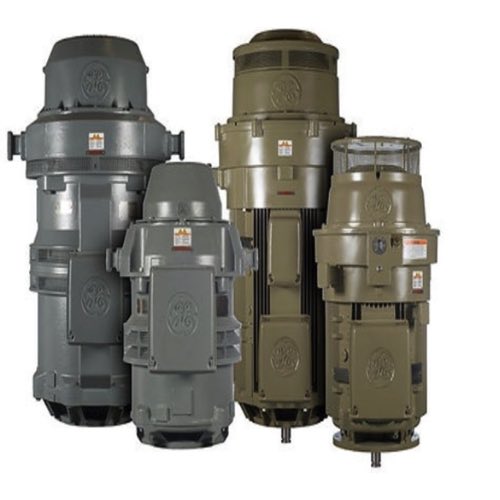GE Vertical Motors

High-performance applications, such as deep well pumping, industrial processing, and power generation, require specially designed motors. Our GE vertical motors are not only configured as hollow shaft motors but also provide the kind of alignment and efficiency that make them ideal for deep well pump applications. With a sustainable insulation system that is built to serve and protect for the life of the motor, these vertically mounted hollow shaft motors are perfect for rough conditions and punishingly humid environments as well as for lineup situations that require great precision.
GE vertical motors are built tough to beat the high-rated service conditions endemic to the heavy industry sector, and each one is very likely to live up to the industry-standard claims made by GE and its many subsidiaries. The components that go into the system design of GE's vertical motors aren't just advanced; they're downright state-of-the-art. It's not hard to find harmony between flexibility and power in the range of HP ratings our vertical motors cover.
More Information about GE Vertical Motors
Businesses that depend on GE vertical motors appreciate that they perform well even in the most extreme conditions. These motors can operate in environments up to 55 degrees Celsius (131 degrees Fahrenheit) and withstand high humidity, dust, and even salt spray. Power plants, municipal water authorities, and manufacturers often use motors that integrate well with existing infrastructure. GE also offers a range of vertical motors that fit well with power requirements from 1 to 500 hp, making them suitable for a variety of applications.
FAQs
What frame size is available for GE vertical hollow shaft motors?
GE vertical hollow shaft motors are available in a range of frame sizes, typically from 182 through 9608.
Motor Starters, Soft Starters & VFDs
Motor Starters
Motor starters safely start and stop a motor in industrial applications. They are designed with a contactor, overload and circuit protection. They are used when basic motor control is required, where torque on the motor is not a concern and speed control is not needed. The advantages of motor starters include: lower cost, allows for remote operation, allows for monitoring of motor state (with the use of auxiliary contacts) and they are safe and efficient. The disadvantages include: high inrush current that can cause fuses to blow and breakers to trip if the inrush is too high, and the starter will allow a full torque to start the motor which can cause the motor to ramp up to full speed very quickly potentially causing the motor to wear and degrade prematurely.
Soft Starters
Soft starters protect motors from inrush current by gently ramping up the motor to full speed. They provide all of the same functions as a traditional motor starter. The advantages of soft starters include: they are less expensive than a VFD when only startup control is needed, they are a smaller system than a VFD where space is a concern and they prevent unwanted torque upon startup, prolonging the life of the motor. The disadvantages include: they are more expensive than a traditional motor starter and they do not allow for full speed control.
Variable Frequency Drives (VFDs)
Variable Frequency Drives (VFDs) allow for the slow ramp up of a motor during startup and the slowing down of the motor during shutdown. They also allow for full speed control during the entire run cycle of the motor. VFDs provide the same functions as both the traditional motor starters and soft starters. The advantages of VFDs include: full speed control (start, stop and in-between), more custom control and monitoring, energy savings due to efficient motor usage and less wear and tear on the motors. The disadvantages include: they are more expensive and larger than other motor control options and they generate heat that may require fans or AC units.

